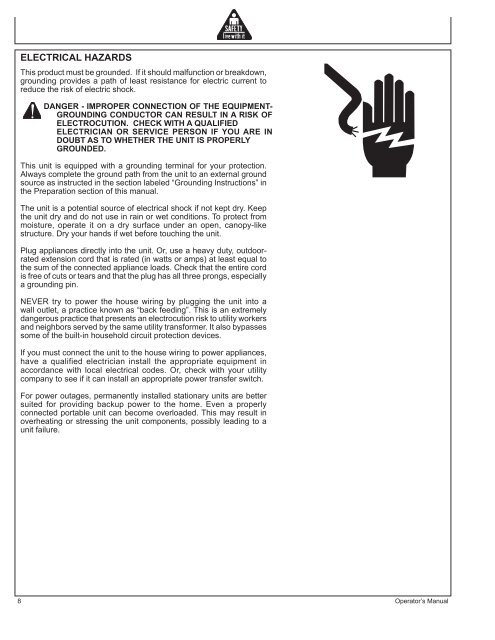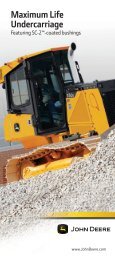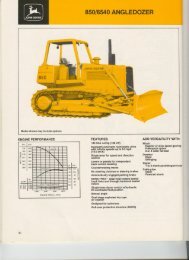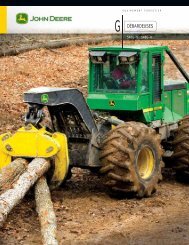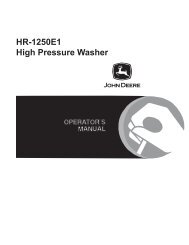Introduction - John Deere
Introduction - John Deere
Introduction - John Deere
Create successful ePaper yourself
Turn your PDF publications into a flip-book with our unique Google optimized e-Paper software.
eleCTRICAl HAzARdS<br />
This product must be grounded. If it should malfunction or breakdown,<br />
grounding provides a path of least resistance for electric current to<br />
reduce the risk of electric shock.<br />
dAnGeR - IMPROPeR COnneCTIOn Of THe equIPMenT-<br />
GROundInG COnduCTOR CAn ReSulT In A RISk Of<br />
eleCTROCuTIOn. CHeCk WITH A quAlIfIed<br />
eleCTRICIAn OR SeRvICe PeRSOn If yOu ARe In<br />
dOubT AS TO WHeTHeR THe unIT IS PROPeRly<br />
GROunded.<br />
This unit is equipped with a grounding terminal for your protection.<br />
Always complete the ground path from the unit to an external ground<br />
source as instructed in the section labeled “Grounding Instructions” in<br />
the Preparation section of this manual.<br />
The unit is a potential source of electrical shock if not kept dry. Keep<br />
the unit dry and do not use in rain or wet conditions. To protect from<br />
moisture, operate it on a dry surface under an open, canopy-like<br />
structure. Dry your hands if wet before touching the unit.<br />
Plug appliances directly into the unit. Or, use a heavy duty, outdoorrated<br />
extension cord that is rated (in watts or amps) at least equal to<br />
the sum of the connected appliance loads. Check that the entire cord<br />
is free of cuts or tears and that the plug has all three prongs, especially<br />
a grounding pin.<br />
NEvER try to power the house wiring by plugging the unit into a<br />
wall outlet, a practice known as “back feeding”. This is an extremely<br />
dangerous practice that presents an electrocution risk to utility workers<br />
and neighbors served by the same utility transformer. It also bypasses<br />
some of the built-in household circuit protection devices.<br />
If you must connect the unit to the house wiring to power appliances,<br />
have a qualified electrician install the appropriate equipment in<br />
accordance with local electrical codes. Or, check with your utility<br />
company to see if it can install an appropriate power transfer switch.<br />
For power outages, permanently installed stationary units are better<br />
suited for providing backup power to the home. Even a properly<br />
connected portable unit can become overloaded. This may result in<br />
overheating or stressing the unit components, possibly leading to a<br />
unit failure.<br />
Operator’s Manual


